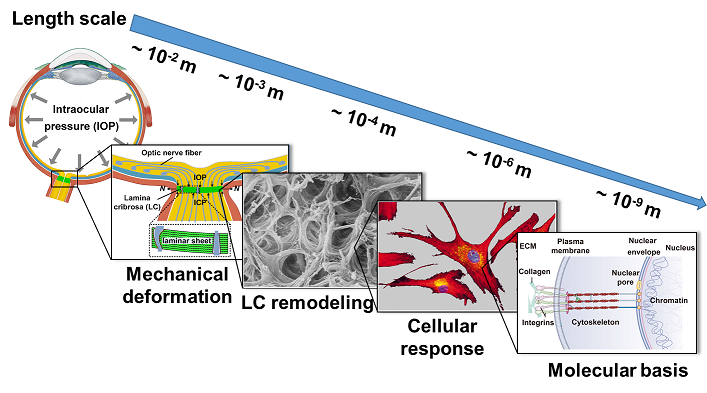Glaucoma, a chronic optic neuropathy, is the leading cause of irreversible blindness worldwide, thought to affect 80 million people. Glaucoma is often referred as the “silent thief of sight” because it typically remains asymptomatic until very severe. Gaining insights into the pathophysiological mechanisms involved in the onset and progression of glaucoma is of great significance in helping improve the diagnosis and treatment of this optic neuropathy. Extensive investigations confirm that the etiopathogenesis of glaucoma is ascribed substantially to the irreversible deformation of the primary site — the lamina cribrosa (LC) of the sclera induced by elevated intraocular pressure (IOP). Decreasing IOP to prevent the further deformation of the LC is the only proven and accepted therapy for glaucoma at present. Due to the technical limitations for in vivo imaging the LC, developing the appropriate mechanical models of the LC under elevated IOP remains the most efficient way to elucidate the glaucomatous pathogenesis to contribute to diagnosing and treating glaucoma.
In a new article published in the National Science Review, researchers from the Institute of Mechanics, Chinese Academy of Sciences review the mechanical models on different scales which try to elucidate potential pathogenetic mechanism by studying the biomechanical behaviors and responses of the LC to elevated IOP. The current understanding from the macroscale deformations to the resultant micro-structural responses of the LC, which are responsible for the occurrence of glaucoma, is presented. Meanwhile, the open issues and avenues for further development are highlighted. This work will help readers gain a bird’s-eye view of the area along with a deeper understanding with regard to the pathogenetic mechanisms of glaucoma, and provide guidance for clinicians and researchers planning to conduct further research.
This work entitled “Biomechanical research into lamina cribrosa in glaucoma” has been published in National Science Review (2020, 7: 1227-1279).
The paper link: https://academic.oup.com/nsr/article/7/8/1277/5819032
The authors acknowledge support from the NSFC Basic Science Center Program for ‘Multiscale Problems in Nonlinear Mechanics’ (11988102), the National Natural Science Foundation of China (11972041 and 11902327), the Strategic Priority Research Program of the Chinese Academy of Sciences (XDB22040102).

Figure 1. Mechanical responses of the LC to glaucoma at different length scales resulting from elevated IOP.